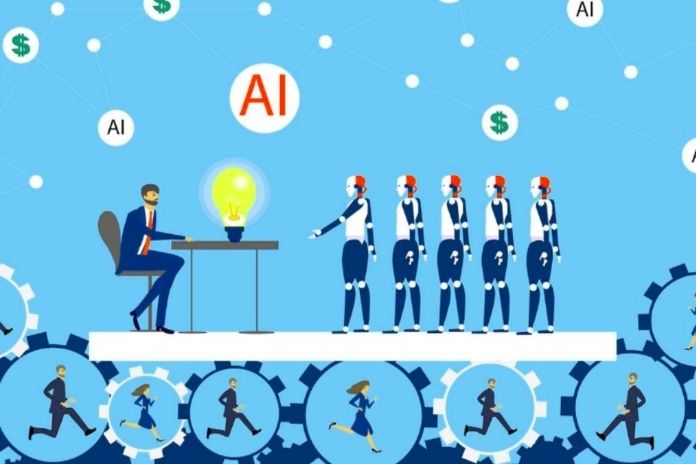With the beginning of industrialization, automation also found its way into many companies. Routine business processes such as accounts payable or order management could be made more efficient with the help of automation tools. Even industry-specific functions – such as claims management for insurance companies or lending for banks – can now get by with little human or manual intervention thanks to Robotic Process Automation (RPA).
Traditional automation software has so far concentrated more and more on the implementation of processes. Modern automation also includes the integration of artificial intelligence (AI) into the RPA – this creates intelligent automation that expands human capabilities. But is it possible to increase the added value of automation even further?
Hyper-automation is a further development of automation with the help of complex AI-based tools and software and an ecosystem consisting of platforms and systems. In this way, automation is extended to every business process in an organization that can be automated. The technology also helps companies automate complex business decisions. However, to fully exploit the potential, companies must invest in sophisticated technologies and gain access to the necessary amounts of data to advance automation on a large scale. But are today’s companies ready for it?
Obstacles On The Way To Hyper-Automation
The path to effective hyper-automation is associated with challenges: a lack of foresight can, for example, lead to investments in solutions that are either not scalable or cannot be easily integrated with other tools – this means that automation does not take place across the board but in silos. The automation landscape offers numerous solutions, and companies are often faced with which functions to invest in. Equally important is the long-term “durability” of a solution and the vendor’s stability – these factors can affect both support and the enhancements required to keep pace with changing requirements.
A lack of advice or expertise on integrating RPA with other tools is a common obstacle, especially if employees do not have the required skills. Automation is often not accepted by employees due to fear of losing their job. This, in turn, affects the corporate culture and can quickly become an obstacle that is difficult to overcome. For this reason, all actors along the entire automation chain should have the same level of AI maturity to maximize the benefits. Another obstacle: unstructured data and security concerns can doom hyper-automation initiatives to failure.
How Can Companies Prepare For Hyper-Automation?
Companies can invest in the most complex AI-based automation solutions. Still, they will not deliver the desired added value if these are not aligned with the long-term strategic roadmap for hyper-automation. Therefore, those responsible for technological innovations should plan end-to-end automation aligned with the general business goals. The roadmap must contain complementary technologies that are both scalable and easy to integrate.
The first step to hyper-automation is to assess a company’s AI maturity level. The company develops a long-term strategy that ensures that decision-making when purchasing technology is streamlined. The focus should be on optimizing sales, costs, risks, and quality. The next step is to assess various technology markets and create an investment plan to achieve tactical and strategic business value effectively.
Does the investment increase sales? Will it improve processes, strengthen customer loyalty or introduce new services – these are some questions companies should ask themselves. The choice of automation tools must help optimize costs – errors are reduced, and processes are accelerated and made more efficient.
Any automation must take into account the risk of non-compliance with legal regulations. Adding AI to the automation mix brings legal, ethical, and compliance responsibilities that organizations must be aware of. To build trust and prepare for future guidelines, organizations should ensure that the AI implementation is explainable. The success of the automation also depends on selecting the appropriate data for each application and the assurance of its quality. A strong use case strategy based on business requirements and less on technology can set the course for success early on on the path to hyper-automation.
Developing a powerful integration strategy is critical as it enables centralized management of systems and communication across the enterprise. Organizations need to bring together and orchestrate the various platforms, tools, and software they use for hyper-automation. This requires digital operations tools that are closely based on the automation roadmap. All AI applications need to be integrated with these tools to improve business processes and create long-term value.
None of the steps taken will lead to success without a suitable change management strategy: It is, therefore, essential that companies address their employees’ fears of being laid off due to hyper-automation. Employees must have the opportunity to continue their education and training. This way, they can take on more demanding tasks and let hyper-automation take care of redundant tasks. And: Companies have to recruit the right talent and invest in their continuous training.
Conclusion
After the pandemic, hyper-automation has picked up speed in all industries to increase productivity and capacity, meet fluctuating demands, improve the quality of services and products, and enhance the customer experience. Investments in hyper-automation are expected to increase to achieve operational excellence and resilience as companies benefit from improved ROI.
Also Read: These 12 Technology Trends Will Shape Companies In 2021

